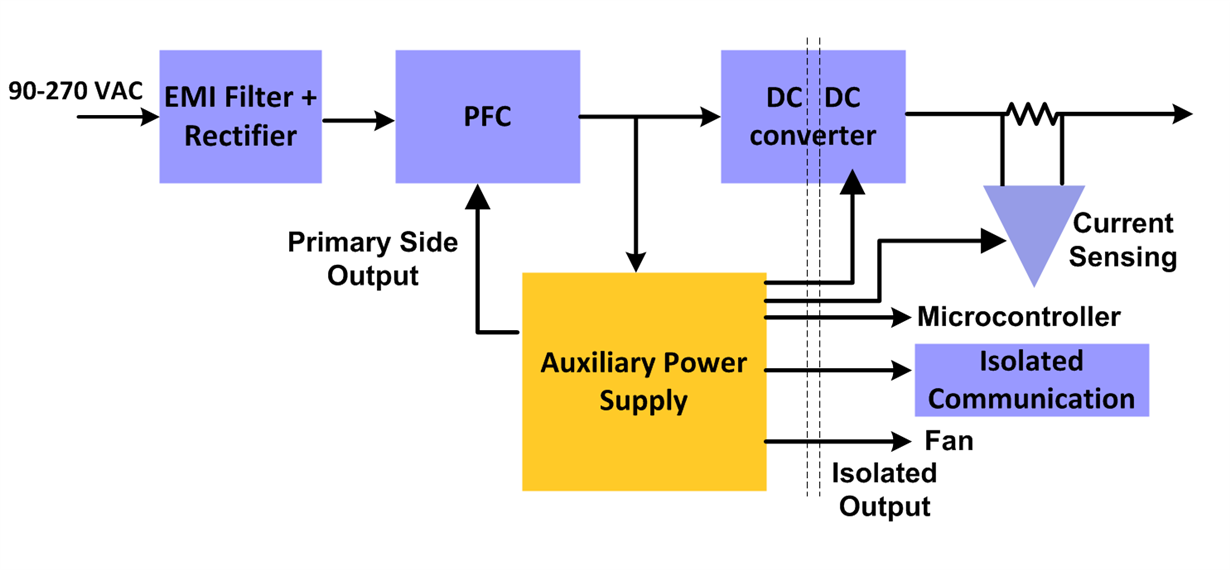-
Common Challenges When Choosing the Auxiliary Power Supply for Your Server PSU
Common Challenges When Choosing the Auxiliary Power Supply for Your Server PSU
Neha Nain
High-power converters used in server, telecom and industrial systems need auxiliary power supplies to support the housekeeping needs of the power-supply unit (PSU). Due to the ever-growing need for higher power density, these PSUs use an additional add-on card to support their auxiliary needs.

An auxiliary power supply commonly powers the internal control electronics, voltage and current feedback sensing electronics, system fans and biasing supply. It is an isolated DC/DC converter generating multiple isolated outputs to power primary- and secondary-side control devices ranging from 5W to 40W. Figure 1 shows the typical usage of auxiliary power supply in server PSUs.
 Figure 1 System Block Diagram of a
Server PSU
Figure 1 System Block Diagram of a
Server PSUThe auxiliary power supplies are a part of a larger PSU which contains an electromagnetic interference (EMI) filter, diode bridge and bulk capacitor. The bulk capacitor gives us the rectified DC bus, making these supplies independent isolated DC/DC converter. The auxiliary power supplies must have high efficiency over a wide load range (10% load to full load) in order to help the server PSUs meet 80 PLUS platinum/titanium standards, tight regulation, low cost and low standby power, in sizes as small as possible to maintain high power density. The auxiliary power supply also needs to operate over a wide input range (from 100V to 400VDC); have multiple isolated outputs; and keep the system electronics powered under all conditions to detect faults such as undervoltage, overvoltage and overcurrent.
Topology Selection
While selecting the topology of the DC/DC converter for an auxiliary power supply, keep in mind cost, efficiency, the reinforced isolation requirement for the outputs and the form factor. Since you need isolated outputs, your options are limited to flyback, forward, half /full bridge and push-pull converters.
The power level for the auxiliary power supply is usually low, varying from 5W to 40W. This low power-level requirement eliminates half/full-bridge and push-pull converters due to their expense, component requirements and greater losses. And although the efficiency of both flyback and forward converter topologies is comparable, the forward topology uses an extra inductor at the output, which makes it bulkier and more expensive when compared to a flyback converter.
Since a flyback transformer is really a coupled inductor through which power storage and transfer between the primary and secondary occurs, you do not need a separate inductor for storage. And because the other associated circuitry is simple, the flyback topology is thus a very popular topology for low-power-level converters requiring multiple outputs.
Realizing an Auxiliary Power Supply with Seven Outputs
The 25-W, 88% Efficiency, Multiple Isolated Output, Auxiliary Supply Reference Design for AC-DC Power Supply demonstrates a fully equipped platform for a 25W auxiliary power supply, achieving high efficiency using quasi-resonant (QR) valley switching and primary-side regulation (PSR). This reference design provides 25W of continuous power over a wide DC input range from 120V to 425VDC. It has a flyback power stage implemented using the UCC28700 Valley Switched PSR CC-CV flyback controller to deliver seven outputs: three outputs referred to the primary ground of the transformer and four completely isolated outputs.
The UCC28700’s valley-switching feature helps this design achieve high efficiency. The use of PSR eliminates the need for an optocoupler, which reduces component count and helps reduce the form factor. Another feature that helps reduce the overall design size is the operating frequency. The UCC28700 can go up to a 130kHz switching frequency, which reduces the magnetics size and enables high power density. The form factor of this design is 35mm by 60mm with an EE20 transformer. The maximum efficiency achieved is >88% and the maximum no-load power consumed is ~80mW.
All things considered, the key challenges while building an auxiliary power supply is to provide safe and reliable power while delivering high performance with low power consumption and low bill-of-material (BOM) cost.
Additional resources
- Learn more about stimulating electromagnetic interference from our Power House blog
- Find out how GaN can help with electromagnetic interference
- Download the 25-W, 88% Efficiency, Multiple Isolated Output, Auxiliary Supply Reference Design for AC-DC Power Supply Design Guide
- Learn more about TI’s flyback solutions at www.ti.com/flyback